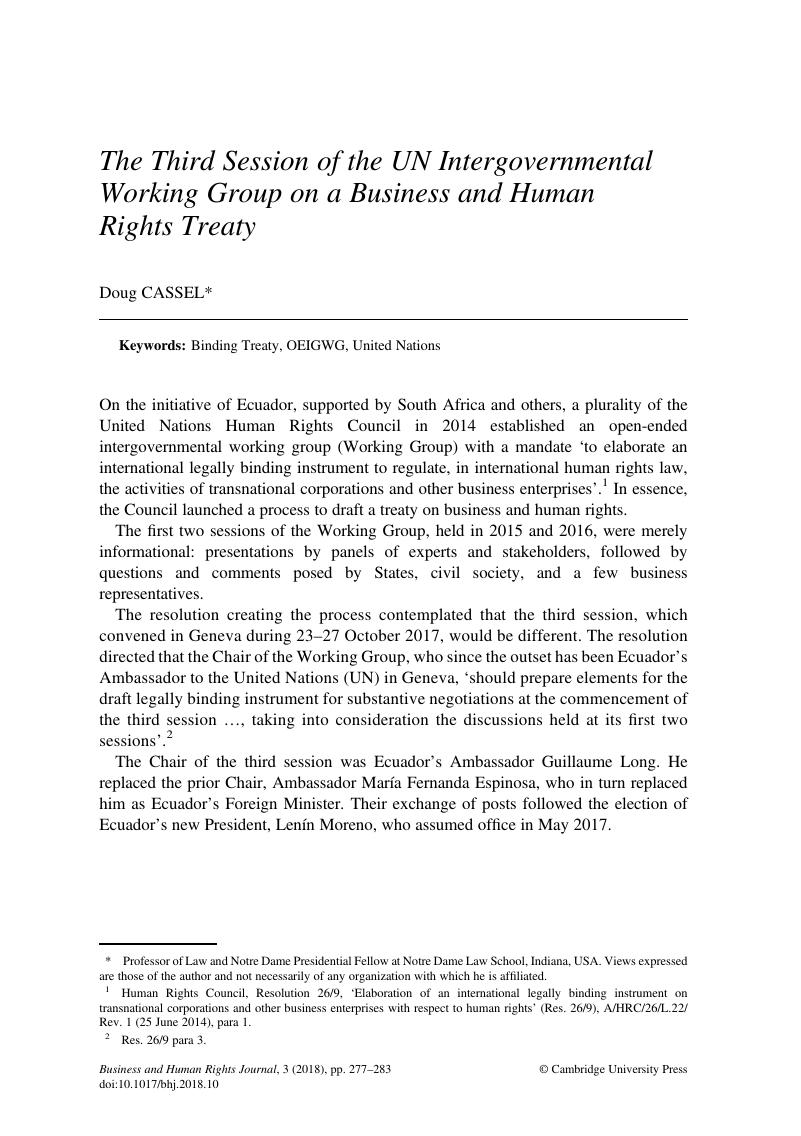Article contents
The Third Session of the UN Intergovernmental Working Group on a Business and Human Rights Treaty
Published online by Cambridge University Press: 24 July 2018
Abstract

- Type
- Developments in the Field
- Information
- Copyright
- © Cambridge University Press
Footnotes
Professor of Law and Notre Dame Presidential Fellow at Notre Dame Law School, Indiana, USA. Views expressed are those of the author and not necessarily of any organization with which he is affiliated.
References
1 Human Rights Council, Resolution 26/9, ‘Elaboration of an international legally binding instrument on transnational corporations and other business enterprises with respect to human rights’ (Res. 26/9), A/HRC/26/L.22/Rev. 1 (25 June 2014), para 1.
2 Res. 26/9 para 3.
3 ‘Elements for the Draft Legally Binding Instrument on Transnational Corporations and Other Business Enterprises with Respect to Human Rights’ (Elements), Chairmanship of the OEIGWG established by HRC Res. A/HRC/26/9 (29 September 2017).
4 Elements § 2.2.
5 Elements § 3.2.
6 Elements § 4.
7 Elements § 7.
8 Elements § 9.
9 Elements §§ 1.2 and 10.
10 ‘Ecuador’s Proposed Elements of a Treaty on Business and Human Rights: Off to a Good Start’, 23 October 2017, https://www.business-humanrights.org/en/ecuador%E2%80%99s-proposed-elements-of-a-treaty-on-business-and-human-rights-off-to-a-good-start (accessed 14 March 2018).
11 Human Rights Council, ‘Report on the third session …’ (Report), A/HRC/37/67 (24 January 2018), para 8.
12 Business at OECD, FTA, ICC and IOE, ‘Response of the international business community to the “Elements” for a draft legally binding instrument on transnational corporations and other business enterprises with respect to human rights’ (Business Response), p 2 (20 October 2017).
13 Elements § 2.2.
14 Elements §§ 4–9.
15 UN Sub-Commission on the Promotion and Protection of Human Rights, ‘Norms on the Responsibilities of Transnational Corporations and Other Business Enterprises with Regard to Human Rights’, E/CN.4/Sub.2/2003/12/Rev.2 (2003).
16 Business Response, pp 2–3.
17 See Report para 71.
18 Elements §§ 5 and 7.
19 See, e.g., Report para 107; Committee on Economic, Social and Cultural Rights, ‘General Comment No. 24 on State Obligations under the International Covenant on Economic, Social and Cultural Rights in the Context of Business Activities’, E/C.12/GC/24 (GC 24) (2017), para 26.
20 Business Response pp 4–5 and 7.
21 Report paras 28, 71 and 107–108.
22 GC 24 para 33.
23 Business Response p 7.
24 For example, International Court of Justice, Germany v Italy, Judgement, ICJ Reports 2012, p 99, paras 54 and 59.
25 Elements § 9.
26 Report paras 120–123.
27 Elements § 6.
28 Business Response pp 7–8.
29 For example, the Crown Prosecution Guidance on the UK Bribery Act explains that it is a defence if a business ‘can show it had adequate procedures in place to prevent persons associated with it from bribing. The standard of proof the defendant would need to discharge in order to prove the defence is on the balance of probabilities’, http://www.cps.gov.uk/legal/a_to_c/bribery_act_2010/ (accessed 15 March 2018).
30 For example, Amnesty International argues that where the relevant information is in the hands of the company, ‘If claimants can prima facie demonstrate that they have suffered harm (the injury) and that this is likely to have been the result of the company’s activities (causation), the law should shift the burden of proof to the corporate defendant.’ ‘Creating a Paradigm Shift: Legal Solutions to Improve Access to Remedy for Corporate Human Rights Abuse’ (2017), p 7.
31 GC 24 para 45.
32 Elements §§ 1.2 and 10.
33 Report paras 32 and 44.
34 Business Response pp 5–6.
35 Report paras 32 and 44.
36 Report para 127.
37 Report para 128.
38 Report paras 19 and 22.
- 10
- Cited by


